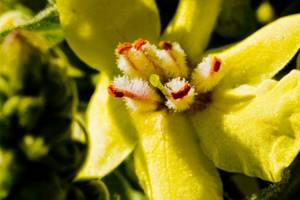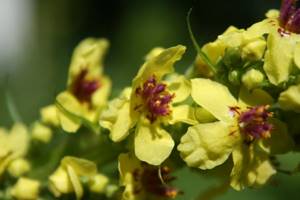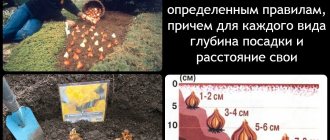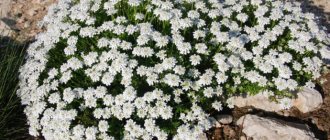Mullein is a stately plant from the Norichinaceae family. Its homeland is the Mediterranean, USA and East Asia. The plant is also known by its Latin name - verbascum, but in our country it is not used so often. Mullein is attracted by its abundant flowering. The tops of its stems are completely hidden under bright, fragrant flowers. Not a single passerby can pass by without admiring the yellow, pink or snow-white inflorescences. Bright flowers attract birds and beneficial insects, so the garden will be filled with chirping and buzzing from early morning. Mullein is completely unpretentious in care, and its beautiful flowers not only please the eye, but also help improve health.
Botanical description
Mullein is a biennial or perennial plant, although annuals are also found in nature. It has a strong taproot and an erect, almost unbranched stem 0.5-3 m high. At the base there is a rather dense rosette of basal leaves. The lower leaves have petioles half the length of the leaf blade. Sessile foliage is located higher up the stem. It is attached oppositely or in a spiral. The leaves have a single oval or heart-shaped leaf blade. Their entire surface, as well as shoots and flowers, is densely covered with felt pile. The shoots and foliage are dark green or gray-green.
From the second year of life, a long stem develops above the leaf rosette, which is topped with an inflorescence. A flowering spike consists of several tiers of buds. At the bottom there are bunches of 4-7 corollas, and at the top there is a bunch of 1-4 smaller flowers. The diameter of the corolla is about 2 cm. It consists of yellow drooping petals and has a tubular or funnel-shaped shape. Under the fluffy, wide-open petals are hidden 5 stamens, varying in size and shape. Flowering continues throughout the summer.
After pollination, a small oblong seed capsule ripens. It is also densely pubescent. Inside there are small oblong seeds. Their rough surface is yellow-brown.
Types of mullein
The mullein genus is very diverse, with more than 250 plant species recorded in it. Only a few are found on Russian territory. They are adapted to climatic conditions and also have excellent healing properties.
Scepter-shaped mullein (dense-flowered). The plant is 20-120 cm tall and has a thick, straight stem that is densely covered with foliage. The lower oval leaves reach 10-40 cm in length, and the size of the upper ones is only 4-10 cm. The long spike-shaped inflorescence is dotted with bunches of yellow flowers. The variety got its name for the resemblance of the inflorescence to the golden royal scepter. The diameter of each corolla is 3.5-5 cm. Fresh flowers have a subtle, pleasant aroma, while dried flowers have a richer honey smell.
Scepter mullein
Common mullein (bear's ear). All parts of the plant are densely covered with long silvery hair. Dark green foliage is located almost along the entire length of the shoot and only the very top is crowned by a short spike-shaped inflorescence. The lower petiolar leaves are 15-30 cm in length. Their size gradually decreases upward. Due to the gradually smaller leaves, the plant resembles a cone from a distance. The inflorescence consists of many small flowers up to 2 cm in diameter.

Black mullein. The plant is 50-120 cm high and has erect stems. Large foliage is located only at the lower third of the shoot. The lower petiolate leaves are ovate or heart-shaped. They are 20 cm long. The long inflorescence is covered with bunches of small yellow flowers. There are brown spots at the base of the petals, and the columns of stamens are decorated with purple fibers.

Black mullein
Mullein officinalis. Stems 0.5-1.5 m high are densely covered with foliage. At the top there is a long inflorescence, which sometimes branches into several shoots. All parts of the plant are covered with thick felt pile. Oval leaves with a blunt edge are 15-25 cm long. Flowers with soft, long petals are collected in groups along the entire length of the inflorescence. Their diameter is 3.5-5.5 cm. The anthers are colored red.

Mullein officinalis
Hybrid mullein. This decorative variety was obtained through interspecific crossing. Its advantage is its large flowers of a wide variety of colors. The height of the shoots depends on the variety and can be less than 50 cm or almost 1.8 m. Popular varieties:
- Mont Blanc is a tall plant with large snow-white flowers;
- Herry Helen - the inflorescence consists of large (up to 10 cm in diameter) bright pink flowers;
- Jackie - a dwarf variety up to 45 cm high, covered with smoky pink flowers;
- Pink Domino - orange stains are visible on large crimson flowers.

Hybrid mullein
Collection of mullein
Flower corollas are collected during the full bloom of flowers in June - August; they (the corollas) are very easily removed from the pedicels completely intact. The collected corollas must be quickly dried immediately, for which they are laid out in a thin layer on clean cloth or paper and dried either directly in the sun or in a warm, well-ventilated room.
Dry whisks must be yellow (not brown) in color. Therefore, both when picking and drying flowers, you should not crush them or pour them in a thick layer, and during drying you need to mix them carefully and make sure that the corollas do not change their color. Browned flowers are unsuitable. Dry whisks become brittle; 8 parts by weight of fresh flowers yield 1 part of dry flowers.
The finished raw material should consist of bright yellow corollas without cups. When squeezing the flowers in your hand, you should not get a lump, and the compressed flowers, due to their elasticity, should quickly take their original shape. When rubbed between your fingers, they easily turn into powder. The smell is faintly aromatic. The taste is sweetish, with a mucous sensation.
Mullein leaves are collected when the plants are flowering, in June-July, by picking off the stem leaves with your hands. The collected material is immediately dried in the sun or in a well-ventilated area. Dried leaves should crumble, not bend.
Reproduction methods
Mullein can be propagated by sowing seeds or rooting cuttings. The seeds remain viable for a long time and are resistant to frost, so they can be sown immediately in open ground. The plant also often self-sows. Due to the taproot, which goes deep into the soil, it is not worth replanting mullein. Therefore, sowing seedlings is not practical. In open ground, seeds are sown immediately in a permanent place. This is done in mid-May or later, when the average daily temperature reaches +13...+18°C. Shoots appear in 1-2 weeks. In the first month, seedlings grow very slowly. Later they develop quite quickly and do not require much care. Flowering is expected in the second year of life. It should be remembered that mullein is easily pollinated, so seedlings can be very different from the mother plants.

Cuttings help preserve varietal characteristics. Cuttings should be cut after the end of the flowering period (August-September), then the likelihood of successful rooting will be much greater. The main plant with root shoots is dug up and freed from the ground. The root is cut into several parts with buds or small shoots. The length of each rhizome should be at least 5-7 cm. The cuttings are laid horizontally in prepared holes. First, they are covered with a layer of sand 5 mm thick, and on top with earth to a height of 15-20 mm. A distance of 40 cm must be maintained between seedlings.
Rules of care
Mullein is an unpretentious and easy plant. Even a beginner can take care of it. For normal development, the plant needs an open sunny place. Slight shading is allowed, but with a significant lack of sunlight, the plant will develop worse.
The soil for planting should be loose and light. A sufficient amount of sand, gravel and peat should be added to clay soil. It is better if the land has moderate fertility. Then mullein can grow on it for several years. But on nutrient soils it develops worse and often dies at the end of the season.
Mullein only needs watering in dry weather. A small amount of water is enough. The soil should dry well between irrigations. For a root that goes deep enough into the ground, recharging with groundwater will not be a problem. But frequent and prolonged stagnation of moisture in the soil will certainly lead to rotting of the roots and death of the plant.

Mullein rarely needs feeding. One fertilizer with a mineral complex during the flowering period is enough. If the soils are fertile, then they can do without fertilizing at all. In order for mullein to live longer than two years, it is recommended to cut off the inflorescence before the seeds ripen. Hybrid varieties, after pruning, are able to bloom again in the same year.
Healing properties of mullein
Mullein is rich in carotene, ascorbic acid, flavonoids, sugars, tannins and essential oil. This herb is known to be an excellent expectorant with anti-inflammatory, anticonvulsant and analgesic effects. Along with this, mullein boasts unique wound-healing capabilities.
The flowers and leaves of Common Mullein have expectorant, emollient, enveloping, anti-inflammatory, analgesic and wound-healing properties. The flowers also have anticonvulsant properties. An infusion of mullein flowers is used for coughs, hemoptysis, whooping cough, inflammation of the lungs and bronchi, severe runny nose with lacrimation, shortness of breath, and asthma. Also for liver disease, spleen and inflammation of the stomach and intestines.
Mullein is often used as one of the components of various medicinal cough , and in addition to its direct effect, it must also be recognized as having the effect of improving the taste of tea.
Use in the garden
Tall plants with such large and beautiful flowers will not go unnoticed in the garden. Especially when it comes to decorative varieties with different colors of petals. Throughout the summer, mullein will attract insects and birds. It begins to bloom when the primroses have already faded and the later perennials have not yet formed buds. Thus, mullein fills the pause in flowering. It is important to choose the right neighbors so that the flower garden looks harmonious. They can be orchis, catnip, salvia, anafalis, sage.

Thickets of mullein are also used as a background in the background of a flower bed. It can be planted in small groups in the middle of the lawn, in rockeries or along paths.
Medicinal properties of the plant
Many varieties of mullein are used in folk medicine. Its flowers, roots and shoots are rich in tannins, vitamins, mucilages, essential oils, and flavonoids. Oils, alcohol tinctures and decoctions from various parts of the plant are used as an anti-inflammatory, expectorant, hemostatic and antimicrobial agent.
Flower decoctions are used to thin thick mucus in the bronchi and lungs. The fresh juice is rubbed on warts to get rid of them. Compresses and masks based on decoction help fight acne. Alcohol and water tinctures are taken for cystitis, bronchial asthma, hypertension, colds, and rheumatism. Mullein is widely used for hemorrhoids, lichen, tuberculosis, as well as diseases of the liver and gastrointestinal tract. To prevent infection from getting into wounds, burned tissues or cracks on the feet, they are sprinkled with dry mullein powder.
Medicinal raw materials are harvested during the flowering period. It is important to remember that each flower lives only one day and fades by evening. Whole corollas are collected in the first half of the day. They are dried under a canopy or in drying ovens at temperatures up to 50°C. Completely dry raw materials are stored in fabric or paper bags for two years.
Mullein has no contraindications, but it should be taken with caution by people prone to allergies. All drugs must be carefully filtered through several layers of fabric. Even a small amount of villi causes severe irritation of the stomach and mucous membranes.
The use of mullein in folk and traditional medicine
The product is used in different forms:
- decoctions;
- alcohol infusions;
- external use in the form of compresses and baths.
Mullein is often treated as part of a medicinal collection that includes other medicinal plants. Internal use is most common - this is how infectious diseases and pathologies of organ systems are treated. External therapy is used to heal the skin, as well as for inflammation of the middle ear.
We treat colds and gastrointestinal diseases
To combat infectious diseases, take half a teaspoon of dried flowers and pour a glass of hot water. It is enough to let it brew for half an hour. The infusion can be gargled, and also taken orally 5-6 times (a few tablespoons before meals).
The same remedy helps with gastritis, colitis and diarrhea. And among infectious pathologies, mullein decoction treats bronchitis, laryngitis and tracheitis.

Mullein is often treated as part of a medicinal collection, which includes other medicinal plants.
For skin healing
If a wound, boil, abrasion or a rash appears, you can make compresses from a decoction of mullein flowers and greens: take a tablespoon and pour two glasses of boiling water, after which the mixture is boiled for half an hour at a low boil. Compresses are made using a bandage and cotton wool; course of treatment until complete recovery.
Important! If the wound has festered and there is pain and stretching, you can take a tablespoon of dry leaves, put them in milk and boil for 4-5 minutes. Change compresses every 4 hours.
How to overcome a hoarse voice
One of the effective means for quickly restoring your voice is to take a teaspoon of mullein flower syrup every day (4-5 times). You can cook it yourself: take a teaspoon of flowers, cook until boiling in 2 cups of boiling water, and then for half an hour over very low heat. After this, half a glass of sugar is added to the solution and cooked further until completely thickened. Hoarseness will go away in 5-7 days.
Also read: European sage (heart grass): medicinal properties and use of the plant

One of the effective remedies for quickly restoring your voice is to take a teaspoon of mullein flower syrup every day.
We treat radiculitis and arthritis
To treat these diseases, an alcohol tincture of flowers and dried herbs is used: 1 part of the mixture (flowers and greens in the same ratio) is poured with 10 parts of vodka. The mixture is infused for 2 weeks and then applied in the form of compresses, which are applied to sore spots and changed 3-4 times a day.
Royal mullein oil
To treat external skin diseases (allergies, itching, eczema, boils), as well as hemorrhoids, a simple recipe for making royal oil is suitable: take 2 teaspoons of fresh flowers and pour them into a bottle of olive oil. The mixture is infused for 1 month in a dark place, and then compresses are used based on it, which are applied to sore spots. It is also used for otitis media and inflammation of the middle ear.











